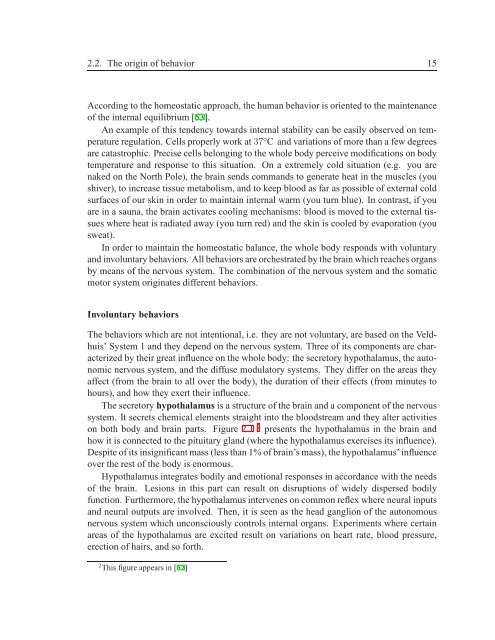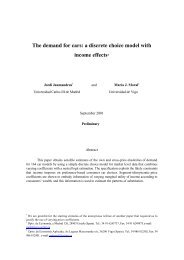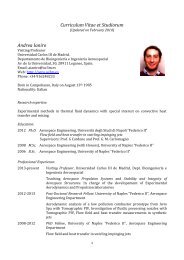TESIS DOCTORAL - Robotics Lab - Universidad Carlos III de Madrid
TESIS DOCTORAL - Robotics Lab - Universidad Carlos III de Madrid
TESIS DOCTORAL - Robotics Lab - Universidad Carlos III de Madrid
Create successful ePaper yourself
Turn your PDF publications into a flip-book with our unique Google optimized e-Paper software.
2.2. The origin of behavior 15According to the homeostatic approach, the human behavior is oriented to the maintenanceof the internal equilibrium [53].An example of this ten<strong>de</strong>ncy towards internal stability can be easily observed on temperatureregulation. Cells properly work at 37°C and variations of more than a few <strong>de</strong>greesare catastrophic. Precise cells belonging to the whole body perceive modifications on bodytemperature and response to this situation. On a extremely cold situation (e.g. you arenaked on the North Pole), the brain sends commands to generate heat in the muscles (youshiver), to increase tissue metabolism, and to keep blood as far as possible of external coldsurfaces of our skin in or<strong>de</strong>r to maintain internal warm (you turn blue). In contrast, if youare in a sauna, the brain activates cooling mechanisms: blood is moved to the external tissueswhere heat is radiated away (you turn red) and the skin is cooled by evaporation (yousweat).In or<strong>de</strong>r to maintain the homeostatic balance, the whole body responds with voluntaryand involuntary behaviors. All behaviors are orchestrated by the brain which reaches organsby means of the nervous system. The combination of the nervous system and the somaticmotor system originates different behaviors.Involuntary behaviorsThe behaviors which are not intentional, i.e. they are not voluntary, are based on the Veldhuis’System 1 and they <strong>de</strong>pend on the nervous system. Three of its components are characterizedby their great influence on the whole body: the secretory hypothalamus, the autonomicnervous system, and the diffuse modulatory systems. They differ on the areas theyaffect (from the brain to all over the body), the duration of their effects (from minutes tohours), and how they exert their influence.The secretory hypothalamus is a structure of the brain and a component of the nervoussystem. It secrets chemical elements straight into the bloodstream and they alter activitieson both body and brain parts. Figure 2.1 2 presents the hypothalamus in the brain andhow it is connected to the pituitary gland (where the hypothalamus exercises its influence).Despite of its insignificant mass (less than 1% of brain’s mass), the hypothalamus’ influenceover the rest of the body is enormous.Hypothalamus integrates bodily and emotional responses in accordance with the needsof the brain. Lesions in this part can result on disruptions of wi<strong>de</strong>ly dispersed bodilyfunction. Furthermore, the hypothalamus intervenes on common reflex where neural inputsand neural outputs are involved. Then, it is seen as the head ganglion of the autonomousnervous system which unconsciously controls internal organs. Experiments where certainareas of the hypothalamus are excited result on variations on heart rate, blood pressure,erection of hairs, and so forth.2 This figure appears in [52]






